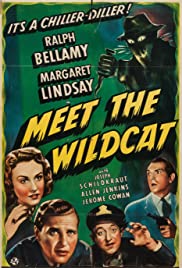
MEET THE WILDCAT
US, 1940, 65 minutes, Black-and-white.
Ralph Bellamy, Margaret Lindsay, Joseph Schildkraut, Allen Jenkins, Jerome Cowan.
Directed by Arthur Lubin.
This is the kind of story that would be a one-hour episode in a television series. It has an exotic setting, an art gallery-museum in Mexico City, as well as police officers. It also has an exotic story about a cat burglar who steals works of art from the museum, signing himself Wildcat. It is also in the vein of the screwball comedy rather than a serious police investigation and the leading lady is one of those very strong-minded investigative reporters.
The reporter is played with vigour by Margaret Lindsay – although, she makes so many errors of judgement leading to difficulties that it does not quite fit with her strong character. And there is Ralph Bellamy, elegant, with a cane, caught by the journalist as he steals a painting. Obviously, the Wildcat. The journalist goes to the police but, surprisingly, they give the impression of supreme indifference.
The other main characters include the proprietor of the museum, played with his usual sinister manner by Joseph Schildkraut. There is the editor of the paper, Jerome Cowan, getting himself entangled with some of the ladies of the city. And, a taxidriver from Brooklyn, played with his usual comic style by Allen Jenkins, a rather unusual presence in Mexico City (though the story of his driving from New York has a little plausibility).
Half way through, it is revealed that Ralph Bellamy is New York police rather than the Wildcat. The journalist is all for tracking him down, then finding out the truth, then get him entangled with the villain and his henchman.
A sting is set up, but the journalist makes some more faux pas and it looks as though the sting will be a failure. In fact, the three main characters are all tied up – but, find a way of signalling an SOS to the police and the raid is successful.
The cast is competent and the film was directed by Arthur Lubin, who made many small-budget supporting features but was soon to direct some Abbott and Costello comedies and, by 1950, start to direct a number of the Francis, the talking mule comedies.